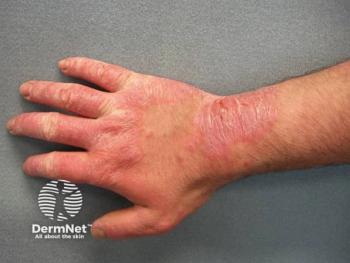
Delgocitinib Cream Shows Minimal Systemic Absorption in CHE
Key Takeaways
- Delgocitinib cream shows minimal systemic absorption, with a relative bioavailability of 0.6% compared to oral administration.
- The study reported no adverse events with topical use, while mild events occurred in oral trials.
Delgocitinib cream offers a safe, effective treatment for chronic hand eczema with minimal systemic absorption, ensuring no significant immunosuppressive effects.
Chronic Hand Eczema (CHE) can impair daily function and lead to psychosocial and occupational difficulties. Delgocitinib, a topical non-steroidal pan-Janus kinase (JAK) inhibitor, has emerged as a therapeutic option for patients in whom topical corticosteroids are inadequate or contraindicated.1 A recent phase 1 study investigated the systemic exposure and relative bioavailability of delgocitinib cream 20 mg/g in adults with moderate to severe CHE to better understand its pharmacokinetic (PK) and safety profile.2
“Overall, a minimal systemic exposure of topical delgocitinib cream was shown in patients with moderate to severe CHE compared with oral administration of delgocitinib,” researchers behind the study stated. “The relative bioavailability fordelgocitinib cream 20 mg/g versus different oral doses was 0.6%.”
The open-label, single-arm trial (
Results showed that delgocitinib cream exhibited minimal systemic absorption. The geometric mean maximum plasma concentration (Cmax) was 0.50 ng/mL on day 1 and 0.46 ng/mL on day 8. The area under the concentration–time curve (AUC0–12) increased slightly from 2.5 to 3.7 h*ng/mL between days 1 and 8, with no evidence of significant drug accumulation. By contrast, oral delgocitinib demonstrated markedly higher systemic exposure. For example, a 1.5 mg oral dose resulted in a geometric mean Cmax of 7.22 ng/mL—over 10 times greater than that observed with the topical formulation.
The relative bioavailability of delgocitinib cream compared with oral administration was 0.6%. Notably, plasma concentrations of delgocitinib with the cream were over 40-fold below the drug’s in vitro half-maximal inhibitory concentration (IC50) in human whole blood, suggesting that meaningful systemic JAK inhibition is unlikely with topical use.
Researchers stated safety findings were favorable across all studies. No adverse events (AEs) were reported among patients receiving topical delgocitinib. In contrast, mild AEs were observed in participants of the oral delgocitinib studies, although without any apparent dose-response relationship or clinical significance. Delgocitinib was primarily metabolized by CYP3A4/5 enzymes, with minor contributions from other CYP isoforms, and was shown to be a substrate for P-glycoprotein and organic anion/cation transporters. However, given the low systemic exposure from topical application, drug–drug interactions are not anticipated to be clinically meaningful.
Non-clinical toxicity data supported the clinical findings. In long-term dermal toxicity studies in minipigs, no adverse effects were observed even at exposures up to 20-fold higher than those seen in humans.
This study provides reassuring evidence that delgocitinib cream 20 mg/g delivers effective local treatment with negligible systemic absorption. Researchers stated these findings suggest that patients with moderate to severe CHE can use the cream without concern for systemic immunosuppressive effects typically associated with oral JAK inhibitors. The minimal systemic exposure, favorable safety profile, and lack of drug accumulation support the continued development and clinical use of delgocitinib cream in this population.
As topical JAK inhibitors gain traction in dermatology, understanding their pharmacokinetics will be critical to assessing long-term safety. Delgocitinib cream appears to offer a well-tolerated and locally targeted option for managing chronic hand eczema, particularly in patients with limited treatment alternatives.
References
- Bissonnette R, Warren RB, Pinter A, et al. Efficacy and safety of delgocitinib cream in adults with moderate to severe chronic hand eczema (DELTA 1 and DELTA 2): results from multicentre, randomised, controlled, double-blind, phase 3 trials. Lancet. 2024;404(10451):461-473. doi:10.1016/S0140-6736(24)01027-4
- Thaçi D, Gooderham M, Lovato P, Madsen DE, Soehoel A, Bissonnette R. Systemic exposure and bioavailability of delgocitinib cream in adults with moderate to severe Chronic Hand Eczema. J Eur Acad Dermatol Venereol. Published online June 17, 2025. doi:10.1111/jdv.20777
Newsletter
Like what you’re reading? Subscribe to Dermatology Times for weekly updates on therapies, innovations, and real-world practice tips.



















